10.11.2018
Jim Cantrell, a quiet force behind the new U.S. space industry, is on the verge of an orbital launch with his small satellite launch company, Vector. Here he delves into the past and future of the space industry, as only a veteran who has Forest Gump-ed his way through aerospace history can do.
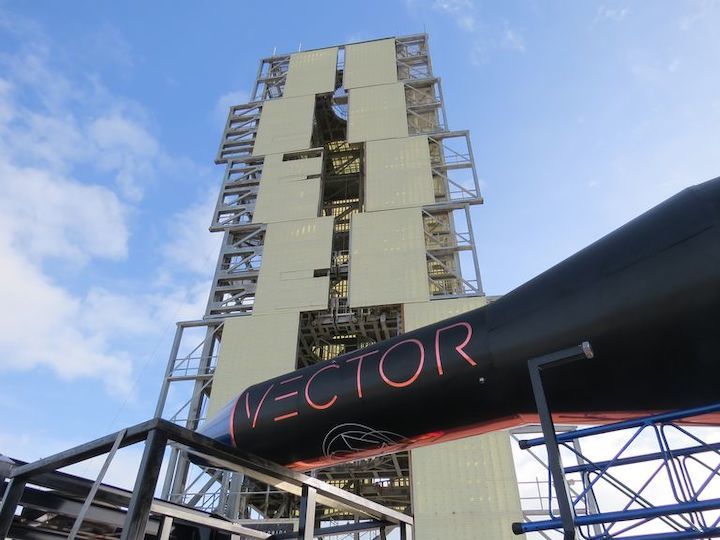
“I'm actually sitting here watching an engine test about to happen,” says Jim Cantrell, founder and CEO of the space launch company Vector. Cantrell is at Vector's home in Tucson, AZ, where he's waiting for a test of his launch system's second-stage engine.
During a four-decade career as a mechanical engineer and entrepreneur, Cantrell has been there for the founding of SpaceX, designed the Planetary Society’s LightSail solar sail program, and formed the Moon Express lunar landing company that competed in the Lunar X Prize and recently received a venture cash infusion to finish building its lunar lander. Now the venerable engineer is the man behind Vector, a startup growing into a major player in the boom business of launching small satellites.
“I'm probably too old to be doing a startup, but here I am,” he says. “My wife's already retired and thinking I've lost my mind, you know, out here doing another one. This is like my fourth one. But dammit, you know, this is something that the world really needs. I felt like we have a solution that's a perfect fit and the right team, and the time and place was only available once in a lifetime.”
Vector’s business plan calls for hauling hundreds of customers’ microsatellites into low-Earth orbit. Instead of piggybacking on larger launch vehicles, these small sats will now have rides built for them that are available on demand. There are about 40 small sat launch companies trying to corner this market, and Vector is at the head of the pack. In late October, the company raised $70 million, money that will help Vector build a fleet of rockets that they can start to rent after Vector’s first orbital launch, which Cantrell says should happen in early 2019.
He's our conversation with Cantrell, which doubles as an insider’s history of the reinvention of American spaceflight.
Popular Mechanics: What was the state of the satellite launch when you first got involved in the space industry?
Cantrell: When I got into the business it was 1986, and my first real job was as an intern at the Jet Propulsion Lab down in Pasadena. At that point things were a lot bigger in general. They were a lot bigger in dollars, they were a lot bigger in size. Pretty much with the exception of commercial satellite operators’ geostationary satellites, the industry was primarily nation-state dominated.
The market itself for commercial satellites was nearly entirely geostationary orbit, which is 26,000-some miles up there. There are only so many slots in geostationary orbit. The satellites themselves in the early days didn't last very long. You know, five, ten years because of the radiation and so on. They were getting replaced. So it was a nice robust market of replacement satellites that were being built. There were like 25 or 30 a year, and the U.S. was the leader in that.
The launchers for those were big launchers, and they were the same launchers that took humans up in scale. Little rockets like Vector didn't exist.
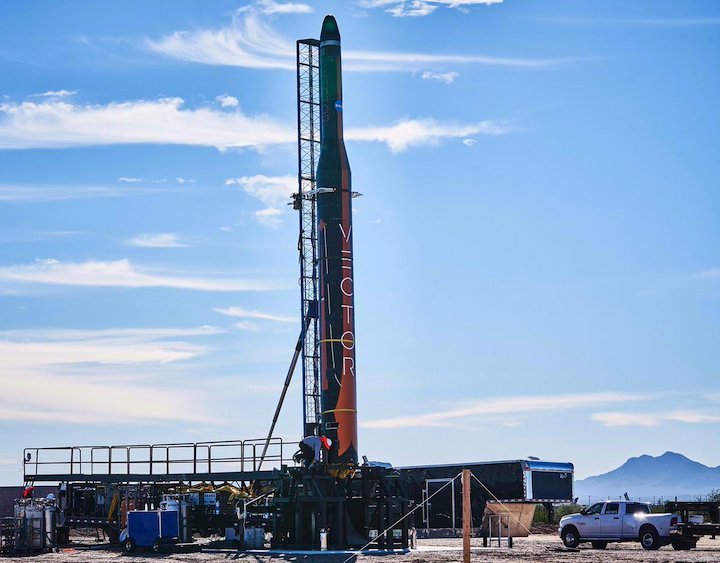
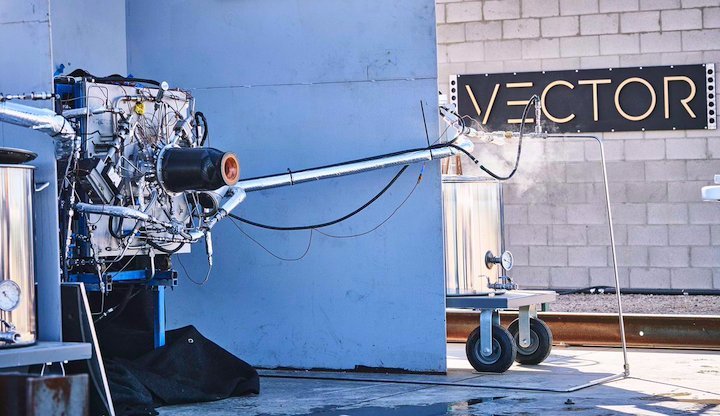
PM: Why didn’t the small sat revolution that we see now work out back then? What was missing?
Jim Cantrell: Here's why I think it didn't work out. I think it was simple cost. These were billion-dollar constellations. But you can only raise about $200 million dollars in venture funding. After you get past that, it either becomes debt or nation state financing. That kind of big check requires a fairly certain return. I don't think that's fundamentally changed today.
But making the satellites smaller made them cheaper, and also made them cheaper to launch. Now what we've got is a situation where these satellites, because of cellphone technology and other things, have managed to come down in price to where people are willing to take more risks. You don't have to go out and raise half a billion or a billion dollars.
For the micro launchers that we're in, we think that $100 million in capitalization is the minimum threshold to be viable. That was one of the reasons I left SpaceX early. When Musk said, "I'm willing to put $100 million dollars into this," we knew what he had in mind and we just didn't think that was enough money. I didn't. I was like, "Okay, he's chasing a fool's errand here."
PM: Vector just raised $70 million. That seems like a lot of money, but your plans are very ambitious.
JC: You know, the $70 million round is very serious. Despite seeming like a lot of money, it's still a very narrow path of success you have to weave through. It's like driving through the narrow streets of Rome—sometimes you don't have much room on either side of the car.
That's kind of what it feels like sometimes. You can't make too many mistakes on that kind of money. We like to think of ourselves as five to ten times more efficient than the government deploying that kind of capital.
PM: What do customers want from a small sat launcher?
JC: The key technical risk on any new satellite company always has been access to launch. That is why, when I decided to start Vector, I said, "This is the problem we have to solve." This is where we're rolling the dice on the company. I believe solving that problem creates even more demand for the product.
That's why we have two products. The late adopters will use our heavy vehicle, the H. Our early adopters will use the R because it's simply cheaper. It's like the Volkswagen Bug versus the Mercedes G-Wagon. So we're really focused on two different markets. We'll make our huge profits on the more mature market. But you can't do one without the other.
PM: What’s the state of the small sat industry, and how do you think it will develop?
JC: This industry is still in a fairly immature stage and the jury's still out as to whether it's gonna be successful. Now, that being said, I'm extremely bullish, obviously. I'm in the business and taking these kinds of risks is why we get disproportionate reward.
We think the SpaceX is actually leaving this part of the market behind to us, and I see where this market's big enough to have two or three competitors just like us. Building and busy as we can be, and we've all got plenty of business. I just don't see our real competition being Rocket Lab and all these other guys. I see it coming from the Indian government. I see it coming from the Chinese, who are splitting up their launches and, to some degree, SpaceX.
But by and large, SpaceX is planning to launch humans. They say it, they say, "We've got billions of payloads into humans," and they don't see small satellites as something worth them doing. In fact, this very rocket that we're building I proposed to Elon as the first rocket for SpaceX and they said it's too small. So I just don't see them coming back to this. Maybe if we prove that we can make a million, billions of dollars and be as valuable as SpaceX they might, but you know, that's years down the road.
PM: The Pentagon is another very interested player in the small satellite market. Is that a new passion?
JC: The part of my career I don't talk much about was actually working with the military on small sats. What we were doing in essence was trying to work with the military to find out the military utility of these very small things, including CubeSats. Part of the motivation for that is visibility. You know, it's like one man's trash is another man's treasure. One man's space debris is another man's weapons system, right?
So if you can't see it and this classifies as space debris it's obviously of interest for to make observations without being detected. That's not a topic that most people talk very much about, and I really don't wanna go into it, about observability of objects in space. But suffice to say there's a great military interest in that topic and time.
The other one is this issue of space control, as it's called, or space warfare. You know, I've gone on the record saying it's in nobody's interest for that to happen. So what you want to look for is the deterrents. That's something I spent a good part of my career in and out of. The deterrent ends up being lots of small satellites.
So there's a lot of operational things that come from this where… this is one thing I'm proud of, you know, the U.S. Air Force and DARPA spent almost a billion dollars to try to build a rapid launch capability. And here we are, a bunch of rednecks with some cash out in the Arizona desert, and we're almost there.
I think the military long-term is a very good anchor tenant for us. We don't see ourselves as a military contractor, that's not the business we want to be in. I'm personally opposed to the Space Fore, because I think it's unnecessary. I'm more on the lines of the small government argument than anything else. Those functions are already being done. But that being said, they want to have this capability. And I see that as a force of peace and I see it as a force of stability, which I'm all for.
What the Chinese did on January 11, 2007, was no surprise to our government. At the time I was briefed into that stuff. We knew they were gonna do a test because we were watching them. They had done three prior and had missed. This time they hit their own satellite and hit the shit out of it. You can quote me on that, there was debris everywhere. Iridium had to deal with it and that was part of what I dealt with at Iridium, later. Oh, here, listen.
JC: Did you hear that?
PM: Was that the engine test?
JC: Yeah, that was a test fire. That was a second-stage engine. What we have on there is what we call our autogenous pressurization system. So our engines don't have pumps, per se, we use pressure in the tank, to force the fuel and the oxygen into the thrusters, as, just for simplicity's argument. Normally to create that pressure you use helium, so that's in a high-pressure bottle like 3000 psi, 4000 psi. You just draw that down as you deplete the fuel.
So what we've come up with, and nobody else has actually done this. SpaceX says they're going to do it, but we're the only ones that have actually made it work, is we actually run the liquid oxygen through a heat exchanger and the fuel, the propylene, through another parallel heat exchanger that takes heat from the actual engine itself. It creates a high-pressure, high-temperature gas which we pump back into the tank. So we pump the gaseous oxygen back into the liquid oxygen tank, and the gaseous propylene back into the liquid propylene tank.
Because we pump it into the top, it stratifies thermally. The hot gas at the top and the cool liquid at the bottom don't (immediately) mix. We're trying to fine-tune it so that we can get rid of the helium bottles. That saves us a lot on mass, that's how we make this whole thing simpler. We don't have to load the helium on the pad, we don't have the danger of high-pressure helium bottles, all that good stuff.
PM: Isn't that the answer to what your wife was asking, why you're doing this, why you're doing another startup? I mean, come on. If that noise isn't the answer, I don't know what is.
JC: Well, it's super cool, I'll tell you that much. I race cars, though, for fun and games. The real answer is, besides this being a thrilling thing and a good thing to do, it hopefully makes me enough money to form a Le Mans team and go win Le Mans. That's my real goal.
PM: Well, you know, a guy's got to have some dreams after all! So when’s Vector’s first orbital launch?
JC: We think the likely date is probably after the New Year. We think the given delivery, late deliveries of some supplier pieces, and some software issues and some other things, we're gonna miss the last boat to Alaska for the end of the year. There's barges that go up there. To get our mobile launch system, which we're testing, to here up there it has to be on a barge by a certain date. So we're sort of asking the question, you know, if we hurry up and get that are we better off just leaving it here and doing some more testing? So we're kind of leaning toward that. My gut sense is January is when they'll fly. It could flip into February, but I don't see it going past that.
You know, as we say, sh*t happens.
Making smallsat rockets at Vector
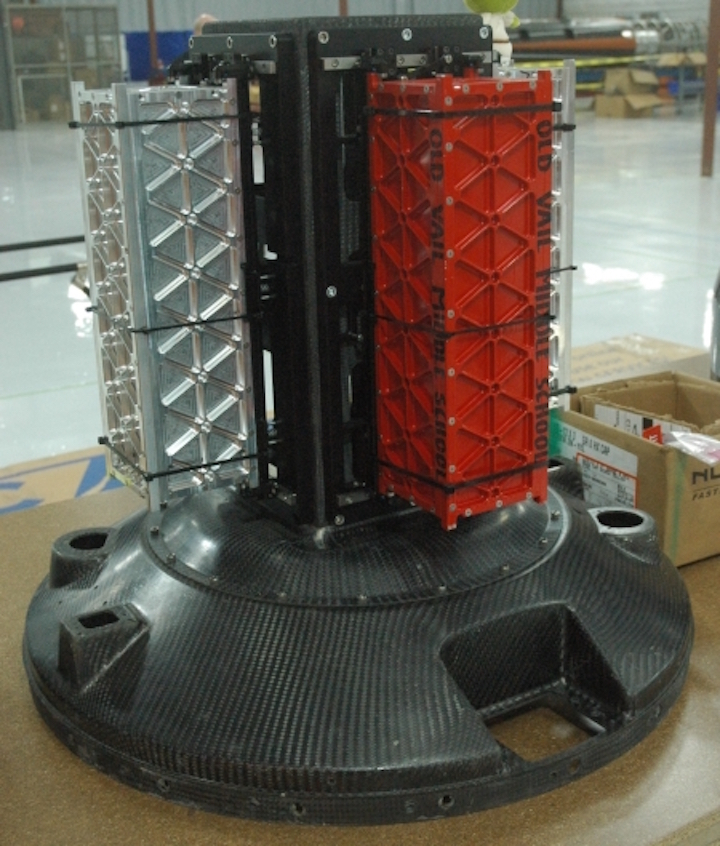
In the coming year we should see the spectacular first launches from two smallsat rocket companies, Vector and Virgin Orbit, joining Rocket Lab (which has already launched successfully three times) to form an entirely new industry of small rockets designed specifically for launching cubesat and nanosat satellites, what I call smallsats.
The image on the right shows the payload adapter fitting for Vector’s Vector-R rocket. The red and silver rectangular objects are dummy cubesat payloads. Overall, this structure, only about three feet high, will allow Vector to place as many as eight smallsats into orbit on one launch.
The picture was taken yesterday during a tour of Vector’s facilities given to me personally by Vector’s CEO, Jim Cantrell. During my previous tour of Vector back in March 2017, Cantrell had described the company’s planned test launch schedule as follows:
The company is presently in the testing phase leading up to their first orbital launches, which they hope to start in 2018. Right now they are building a series of full scale versions of their Vector-R rocket with a dummy second stage. The idea is to do a string of suborbital test flights, the first of which will fly in about a week from Mohave in California, with the second flying from the Georgia spaceport in Camden County.
The first two launches occurred as promised, first in Mojave on May 3, 2017 and then in Georgia on August 3, 2017. An announcement in October 2017 set the launch of the third test first for January 2018 but that launch did not happen. In March 2018 Vector announced it planned to launch two cubesats into orbit from Alaska by the end of 2018, but this did not happen either.
Because of the delays, with no explanation, I was beginning to harbor doubts about the company’s status. Last week Cantrell gave a talk at Tucson’s Space Business Roundtable, and I went to that talk to find out what the issues were as well as attempt to find out when they did plan to launch.
Cantrell not only filled me in on the details, but generously offered to give me another personal tour of Vector’s facilities, which had grown significantly since my 2017 tour. Then, Vector employed only thirty people and was based in a small warehouse. Now it employs more than 150, and has two much larger facilities in Tucson as well as one in California (where its mission control is based).
First let me outline the company’s launch status.
The third suborbital test that had been originally announced for January 2018 launch not surprisingly had been repeatedly delayed due to technical issues until the summer of 2018, when the company decided to completely stand down that rocket and use it instead for testing. Subsequently they have conducted a number of different tests with it, including about a dozen vertical static fire tests as well as countdown dress rehearsals designed to work out the details for fueling and unfueling their rockets during launches as well as training their launch teams at the launch site and at mission control. “We realized that this rocket would be much more useful to use as a testbed that can be used repeatedly in many different ways than as in a single one time test flight,” Cantrell explained. The image below shows this test rocket as it sits in the Vector rocket assembly building in downtown Tucson.
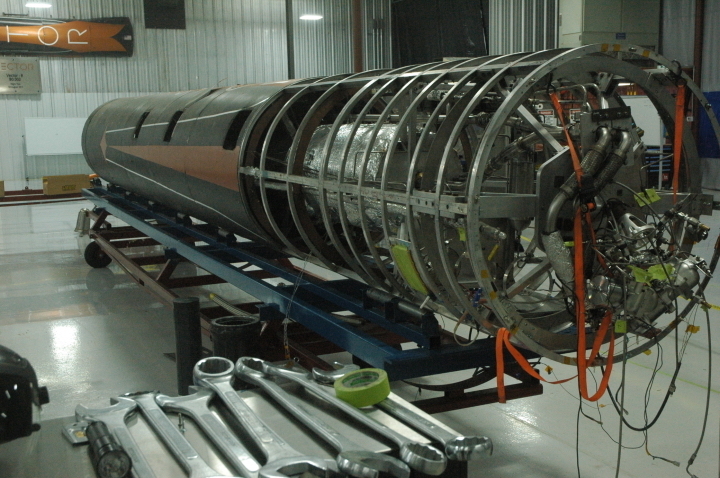
Even with this decision, they had still hoped to make their next launch, #4 in their original test schedule, by the end of 2018, from Alaska. This test would test the first stage from launch to main engine cutoff, followed by first stage separation. They would then do a valve and ignition test of the second stage, where they would simulate ignition but with water instead of fuel. The flight would get the second stage up to about 70 miles, thus placing it in space, though not in orbit.
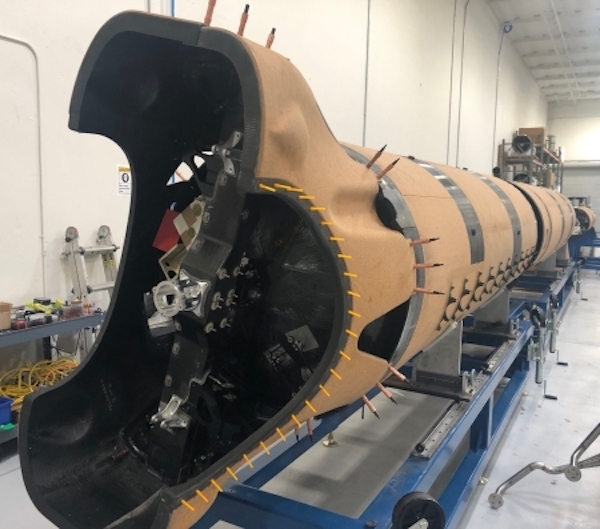
When the GPS component in their flight termination system (the system used to abort a flight during launch) had problems, they were forced to reschedule this flight from December 2018 to March/April 2019. Cantrell noted that they give themselves a 70% chance of meeting that date. At present they are assembling the rocket at their California facility, and plan to do a vertical static fire test of the first stage at the engine test facility north of Tucson prior to that March/April launch. The image on the right shows that rocket during assembly in California, looking at the rocket’s base where its three engines will be installed.
Cantrell then outlined their launch schedule beyond this. If all goes well, they hope to make their first launch to orbit in June, followed by launches in August, October (two), and December. When I told him I would not be surprised if this schedule did not happen, he readily agreed. Like Rocket Lab, these first launches are tests, and when you do tests, you must not be surprised if things to go wrong. Like Rocket Lab however Cantrell is confident they will quickly figure out any issues and move forward.
His confidence seems reasonable, based on the significant capital the company has raised, and based on what I saw during his tour. The image below shows the main assembly floor of their Tucson rocket assembly facility. In the background behind the flagging tape you can see the rocket now used solely as a testbed. In the foreground are two of their future rockets, their fuel and oxygen tank sections lined up with one in front of the other.

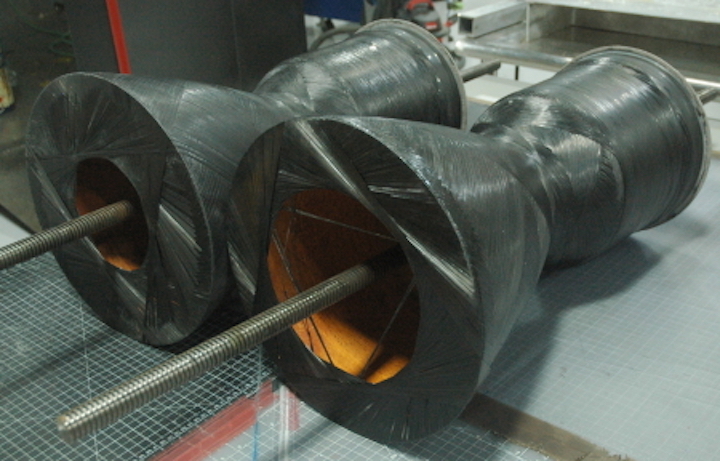
In rooms off to the side of this main assembly floor they have a machine shop as well as facilities for carbon winding the tanks and engine parts. They also 3D print many of their rocket engine parts. The image on the right shows the nozzles/ignition chambers of two partially built engines shortly after a carbon layer has been wound around the outside of the inner ablative structure.
Cantrell next took me to their engine test facility, located in the desert about twenty minutes north of Tucson, where they do all static fire engine tests, including the vertically stacked tests of the rocket’s entire first stage. The image below is of the mobile launch platform they use to transport and launch their rockets. They call it the TEL (Transporter, Erector, Launcher). As they are presently between launches, it is essentially in storage, covered with tarps to protect it from weather. For launch the strongback lifts the rocket to a vertical position at the left end. For transportation they attach a truck to the right end. Imagine passing this on the interstate with a rocket on board. It has happened, and it will happen increasingly in the coming years.
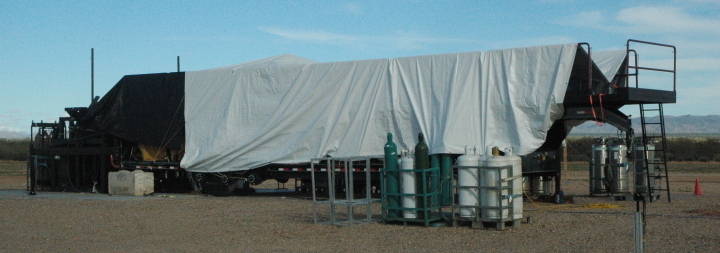
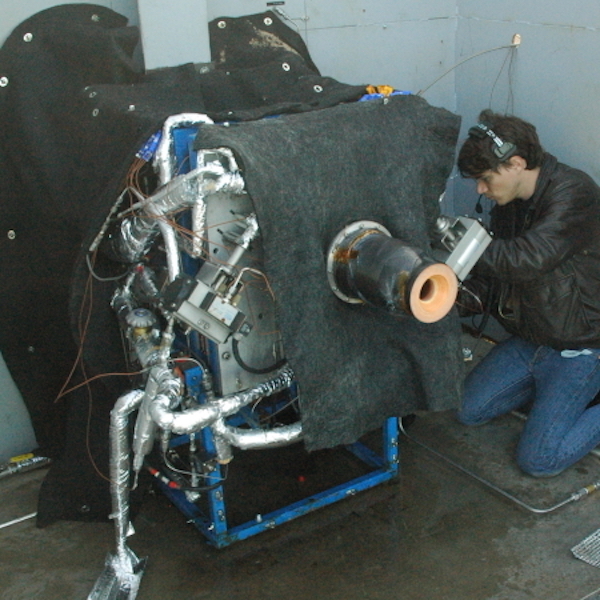
When we arrived at the test facility they were preparing for a series of static fire engine tests of a second stage engine. The photo on the right shows propulsion engineer Chris Boswick as he preps the engine and test equipment. When I took this picture they were hoping to get the test off in about an hour. However, they do not rush things at this stage, as forgetting to do one tiny task can ruin the test. One hour turned into two, then three. When they were about to fire the engine for the first five second burst, just before sunset, their sensors detected a valve leak and they had to abort. While they were going to try to get it fixed and fire the engine that night, they figured it likely that they would need to come back the next day, so at that point I decided it wasn’t worth waiting any longer. Cantrell has promised that I will be invited for later and much larger tests, such as when they mount the March/April rocket for a dress rehearsal vertical static fire test prior to that launch.
In conclusion, Vector is without doubt in the business of making and launching of rockets. Whether they survive of course will depend on those initial launches later this year. While they might have a launch failure or even two (as SpaceX did in its early days with the Falcon 1), they will eventually have to perform, or the investment capital will dry up and they will run out of money.
Right now, however, I suspect that they will be able to weather at least two failures, since the demand for these smallsat launchers is increasing at an amazing rate, and right now there is only one company (Rocket Lab) that is barely operational, and only one other company (Virgin Orbit) even close to its first test flights. There is opportunity here to make a lot of money, and it appears that investors have recognized this fact by pouring substantial capital into the industry.
https://behindtheblack.com/behind-the-black/essays-and-commentaries/making-smallsat-rockets-at-vector/
Quelle: Behin the Black
